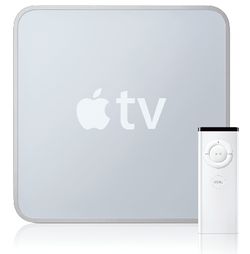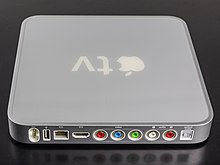 .
. 
Apple TV. 1st generation
1st generation
Macworld San Francisco banner “Introducing Apple TV”, January 9, 2007
Apple TV was unveiled as a work in progress called “iTV” on September 12, 2006 at an Apple Special Event using a modified Front Row interface using the Apple Remote.[27][28] Apple started taking pre-orders for Apple TV on January 9, 2007. The name “iTV” was originally going to be used to keep the product in line with the rest of their “i”-based products (iMac, iPod, etc.), but was not used because the British terrestrial broadcast network ITV holds the rights to the name in the UK and threatened to take legal action against Apple.[29]
Apple TV first shipped on March 21, 2007 with a 40 GB hard disk.[30] A updated model with a 160 GB HDD was released on May 31, 2007; subsequently, Apple ceased selling the 40 GB HDD version on September 14, 2009.[31]
On January 15, 2008, a software upgrade was announced; this turned the Apple TV into a stand-alone device which removed the requirement for a computer running iTunes on Mac OS X or Windows to stream or sync content to it, and making most of the Apple TV’s hard disk redundant. The update allowed the iTunes Store content to be directly rented and purchased, as well as photo streaming and podcast downloads from MobileMe (which was called .Mac at the time) and Flickr.[32] Front Row became deprecated, and a new interface was introduced for the original Apple TV in which content was organized into six categories, all of which appeared in a large square box on the screen upon startup (movies, TV shows, music, YouTube, podcasts, and photos) and presented in the initial menu, along with a “Settings” option for configuration, including software updates.[33][34]
On July 10, 2008, Apple released the iTunes Remote app on the App Store,[35] and the Apple TV 2.1 software update that added recognition for the iPhone and iPod Touch as remote control devices intended as a software alternative to the Apple Remote.[36] Later updates to the Apple TV, iTunes, and Remote software added support for the iPad, and introduced support for new features as they were added to iTunes.[citation needed]
In July 2011, Apple discontinued the Front Row interface for Mac users.[37]
On September 9, 2015, Apple discontinued service and support for the first generation Apple TV.[5] Beginning May 25, 2018, iTunes Store is no longer accessible from the device, due to its obsolete security standards.[38]
2nd generation
The 2nd generation Apple TV was announced on September 1, 2010, and was the first to run on a variant of iOS.[39][40][41] The device is housed in a smaller, all-black case, one-quarter the size of the original. This model replaced the internal hard drive with 8 GB internal flash storage, enough local storage for buffering purposes; all media became streamed, instead of synced. It supports output up to 720p over HDMI only.[42][43]
In May 2015, the YouTube app was removed due to an API change by Google.[44]
3rd generation[edit]
On March 7, 2012, Apple announced the 3rd generation Apple TV (model A1427) at an Apple Special Event. It is identical externally to the second generation model, includes a single-core A5 processor, and supports 1080p output.[45]
Apple silently released a third generation “Rev A” (model A1469) on January 28, 2013 with component changes included. This refreshed model gained support for peer to peer Airplay which allowed iOS devices to mirror to the Apple TV without requiring both devices to be on the same Wi-Fi network. This model also saw the dual-core Apple A5 chip with one core deactivated being replaced with a single-core variant of the A5 chip. Some users reported the Rev A drawing less power than the original 3rd generation Apple TV. By October 2016, Apple had phased out the Apple TV third generation, with Apple Store employees instructed to pull all units and demo units from store shelves.[46]
Amazon Video was added with Software 7.2.2 released on December 6, 2017.[47] The TV app was added with Software 7.3 released on May 13, 2019.[48] Support for HBO Go and HBO Now ended in April 2020.[49]
4th generation (HD)
On September 9, 2015, Apple announced the 4th generation Apple TV at an Apple Special Event. The 4th generation model uses a new operating system, tvOS, with an app store, allowing downloads of third-party apps for video, audio, games and other content. Upon release, third-party apps were available from a limited range of providers, with new APIs providing opportunities for more apps. A requirement of new apps and games was that they must include interfacing with the new touchpad-enabled Siri remote, which was later relaxed for games.[50][51][unreliable source?] In March 2019 Apple rebranded the device as Apple TV HD.[52]
The 4th generation includes a 64-bit Apple A8 processor, and adds support for Dolby Digital Plus audio. While similar to the form factor of the 2nd and 3rd generation models, the 4th generation model is taller. In contrast to the old remote’s arrow button, the 4th generation Apple TV’s touch remote uses swipe-to-select features, Siri support, a built-in microphone, volume control over HDMI CEC and IR, and an accelerometer (IMU).[53]
The 4th generation Apple TV started shipping in October 2015. Upon launch, there were several unexpected issues such as incompatibility with Apple’s own Remote app for iOS and watchOS.[54] These issues were fixed by Apple on December 8, 2015 in tvOS 9.1.[55] On September 13, 2016, Apple released tvOS 10, bringing an all new remote app, single-sign on, dark mode, HomeKit support, and other features.
Amazon initially declined to develop an Amazon Video application for Apple TV, and announced in October 2015 it would stop selling Apple TVs, and removed 3rd generation SKUs.[56] In late 2017 Amazon reversed their stance and released an Amazon Video app,[57] and resumed sales of Apple TVs.[58]
5th generation (4K)
At an Apple Special Event on September 12, 2017, Apple announced the 5th generation Apple TV, named Apple TV 4K, which supports 2160p output, HDR10, Dolby Vision, and includes a faster Apple A10X Fusion processor supporting HEVC hardware decoding. Dolby Atmos support was added in tvOS 12.[59][60] Following the announcement of the new models, the 64 GB version of the 4th generation Apple TV was discontinued.[61]
Externally it is similar to the 4th generation model, with the only differences being the addition of vents on the base, the removal of the USB-C port, and the addition of a white outline around the menu button on the included Siri Remote.
Video:
Here’s the actual item in my museum
<my photo>
The Apple TV (white) basics:
Color: White | OS: tvOS

